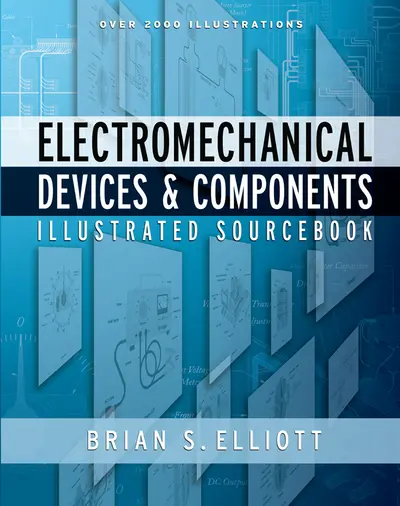My Account Details

ISBN10: 0071477527 | ISBN13: 9780071477529

Step 1 . Download Adobe Digital Editions to your PC or Mac desktop/laptop.
Step 2. Register and authorize your Adobe ID (optional). To access your eBook on multiple devices, first create an Adobe ID at account.adobe.com. Then, open Adobe Digital Editions, go to the Help menu, and select "Authorize Computer" to link your Adobe ID.
Step 3. Open Your eBook. Use Adobe Digital Editions to open the file. If the eBook doesn’t open, contact customer service for assistance.
Publisher's Note: Products purchased from Third Party sellers are not guaranteed by the publisher for quality, authenticity, or access to any online entitlements included with the product.
Get Quick Access to 2,000 Illustrations of Components and Devices Used in Electromechanical Machines and Systems!
Ideal for all engineers and technicians who design, repair, and operate electromechanical equipment, Electromechanical Devices and Components Illustrated Sourcebook provides 2,000 illustrations of the most commonly used elements found in today's electromechanical machines and systems. This essential working tool contains detailed diagrams, drawn to scale, with relevant calculations and tabular information presented for easy reference.
Packed with engineering examples and principles, this easy-to-use guide offers you a comprehensive overview of all the most important and fundamental electromechanical elements. The book includes on-target illustrations of power sources…acoustic devices…electrical controls…circuit breakers…connectors…fuses and motors…heating elements…mechanical switches and relays…vacuum tubes…meters…wire and conductors…sensors and transducers…and much more. Electromechanical Devices and Components Illustrated Sourcebook features:
- 2,000 illustrations of electromechanical components and devices
- Quick access to vital engineering information
- All diagrams drawn to scale, with calculations and tabular data
- Detailed explanations of elements, with graphs and formulae
- A broad range of engineering examples and principles
- A source of innovative ideas for design engineers
This Time-Saving Engineering Tool Includes Illustrations of
• Power Sources • Acoustic Devices • Magnetic Components • Electrical Controls _ Circuit Protection • Heating • Vacuum Tubes • Rotating Equipment • Meters • Connectors • Wire and Conductors • Lighting • Controlling Mechanical Movements • Sensors • StandardsList of IllustrationsPrefaceAcknowledgmentsChapter 1: Basic ElectricityChapter 2: Basic MechanicsChapter 3: Power SourcesChapter 4: Electrical ControlsChapter 5: Magnetic ComponentsChapter 6: Rotating ComponentsChapter 7: HeatingChapter 8: Circuit ProtectionChapter 9: ConnectionsChapter 10: Wire and ConductorsChapter 11: Acoustic DevicesChapter 12: LightingChapter 13: MetersChapter 14: Vacuum TubesChapter 15: SensorsChapter 16: ElectrostaticsChapter 17: Electromechanical MechanismsChapter 18: Electrical SchematicsGlossaryIndex
AcknowledgmentsChapter 1: Basic ElectricityChapter 2: Basic MechanicsChapter 3: Power SourcesChapter 4: Electrical ControlsChapter 5: Magnetic ComponentsChapter 6: Rotating ComponentsChapter 7: HeatingChapter 8: Circuit ProtectionChapter 9: ConnectionsChapter 10: Wire and ConductorsChapter 11: Acoustic DevicesChapter 12: LightingChapter 13: MetersChapter 14: Vacuum TubesChapter 15: SensorsChapter 16: ElectrostaticsChapter 17: Electromechanical MechanismsChapter 18: Electrical SchematicsGlossaryIndex
Chapter 2: Basic MechanicsChapter 3: Power SourcesChapter 4: Electrical ControlsChapter 5: Magnetic ComponentsChapter 6: Rotating ComponentsChapter 7: HeatingChapter 8: Circuit ProtectionChapter 9: ConnectionsChapter 10: Wire and ConductorsChapter 11: Acoustic DevicesChapter 12: LightingChapter 13: MetersChapter 14: Vacuum TubesChapter 15: SensorsChapter 16: ElectrostaticsChapter 17: Electromechanical MechanismsChapter 18: Electrical SchematicsGlossaryIndex
Chapter 4: Electrical ControlsChapter 5: Magnetic ComponentsChapter 6: Rotating ComponentsChapter 7: HeatingChapter 8: Circuit ProtectionChapter 9: ConnectionsChapter 10: Wire and ConductorsChapter 11: Acoustic DevicesChapter 12: LightingChapter 13: MetersChapter 14: Vacuum TubesChapter 15: SensorsChapter 16: ElectrostaticsChapter 17: Electromechanical MechanismsChapter 18: Electrical SchematicsGlossaryIndex
Chapter 6: Rotating ComponentsChapter 7: HeatingChapter 8: Circuit ProtectionChapter 9: ConnectionsChapter 10: Wire and ConductorsChapter 11: Acoustic DevicesChapter 12: LightingChapter 13: MetersChapter 14: Vacuum TubesChapter 15: SensorsChapter 16: ElectrostaticsChapter 17: Electromechanical MechanismsChapter 18: Electrical SchematicsGlossaryIndex
Chapter 8: Circuit ProtectionChapter 9: ConnectionsChapter 10: Wire and ConductorsChapter 11: Acoustic DevicesChapter 12: LightingChapter 13: MetersChapter 14: Vacuum TubesChapter 15: SensorsChapter 16: ElectrostaticsChapter 17: Electromechanical MechanismsChapter 18: Electrical SchematicsGlossaryIndex
Chapter 10: Wire and ConductorsChapter 11: Acoustic DevicesChapter 12: LightingChapter 13: MetersChapter 14: Vacuum TubesChapter 15: SensorsChapter 16: ElectrostaticsChapter 17: Electromechanical MechanismsChapter 18: Electrical SchematicsGlossaryIndex
Chapter 12: LightingChapter 13: MetersChapter 14: Vacuum TubesChapter 15: SensorsChapter 16: ElectrostaticsChapter 17: Electromechanical MechanismsChapter 18: Electrical SchematicsGlossaryIndex
Chapter 14: Vacuum TubesChapter 15: SensorsChapter 16: ElectrostaticsChapter 17: Electromechanical MechanismsChapter 18: Electrical SchematicsGlossaryIndex
Chapter 16: ElectrostaticsChapter 17: Electromechanical MechanismsChapter 18: Electrical SchematicsGlossaryIndex
Chapter 18: Electrical SchematicsGlossaryIndex
Index
Need support? We're here to help - Get real-world support and resources every step of the way.